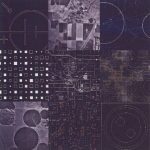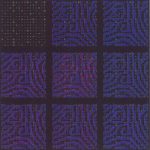Jeff Brice: Emergent Codes
Artist(s):
Title:
- Emergent Codes
Exhibition:
Creation Year:
- 2002
Medium:
- Roland prints on canvas
Category:
Keywords:
Artist Statement:
These pieces are from a body of work entitled Emergent Codes. They are inspired by some recent technological and scientific innovations, including cellular automata, fractal geometry, complex systems, chaos theory, connectionism, Turing waves, and remote sensing. These exciting discoveries are creating remarkable, never-before-seen images of our world and the processes that create it. The catalyst for these broad changes in our understanding is the introduction and use of the digital computer and its ability to crunch complex calculations that were never before possible. As an artist, I am communicating my own personal vocabulary inspired by the artifacts of science. So it seems appropriate to use the computer as an art tool to discuss ideas that have come into being as a result of the computer.
Technical Information:
The computer lies at the core of this series of work. The inspiration comes from recent scientific discoveries that could be categorized as post-structuralist. The post-structuralist paradigm has come about largely due to the immense number-crunching ability of the digital computer, and it really is a philosophy born of the computer age. So it seems only fitting to use the computer as a tool to talk about these new ideas. I begin by creating a graphic vocabulary, drawing inspiration from scientific artifacts such as diagrams, satellite photos, market analysis graphs, etc. I create the simple geometric elements using the Postscript graphics program Freehand, which allows me to create elements that are very precise, so the elements line up properly when placed on a grid. Working in Postscript also allows me to import the graphics into Fontographer, a program that can create font sets. I then use Fontographer to create font sets of graphic elements. I have created half a dozen or so fonts with names such as Vector, Connectionist, Rhizo, Neural net, Crop Circle, and Al. Putting the elements into Fontographer helps automate the process of layering and reinforces the language and machine aspect of the process. I create the final pieces in Freehand, which has excellent layer control and, of course, keeps the process in Postscript.
Process Information:
I start with a basic concept that I would like to explore. Urban Growth is inspired by satellite photos and fractal simulations of city morphology. Like all art activities, the layering is a nonlinear process. The structure of the piece has a tendency to self-organize at some point in a way that I never can foresee. The interaction of the different layers of code begins to dictate how the final piece will evolve. Finally, color is used to enhance the depth of the piece and as a way to bring about a sense of light. The differentiation of short-wavelength color (red) and long wave-length color (blue) is used by the anaglyph 3D glasses to create depth.
The first panel is called the inspiration panel. It consists of nine images of satellite photos and screen captures of programs that I use to create the final artwork. By juxtaposing the screen captures to photos that are implied in the artwork, I hope to create a sense of the dialogue of the different influences that goes into my work. The second panel hanging below the artwork is called the deconstruction panel. It shows in nine steps the layering of the image from back to top. This allows the viewer to see how the back layers influence the front layers.
Other Information:
Images:
1: Turing Wave inspiration
2: Turing Wave deconstruction
3: Urban Growth inspiration
4: Urban Growth deconstruction
All images: 33 x 33 inches, Roland print on canvas










